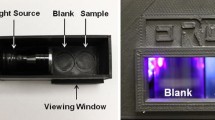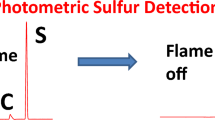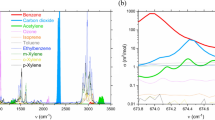Abstract.
A multi-channel detection system utilizing fiber optics has been developed for the laser-induced fluorescence (LIF) analysis of chromatographic eluents. It has been applied to the detection of polycyclic aromatic hydrocarbons (PAH) in a chromatographically overlapped standard mixture and to a complex soil sample extract obtained during fieldwork. The instrument utilizes dual-fiber optic arrays, one to deliver multiple excitation wavelengths (258–342 nm) generated by a Raman shifter, and the other to collect fluorescence generated by the sample at each excitation wavelength; the collected fluorescence is dispersed and detected with a spectrograph/CCD combination. The resulting data were arranged into excitation emission matrices (EEM) for visualization and data analysis. Rapid characterization of PAH mixtures was achieved under isocratic chromatographic conditions (1.5 mL min–1 and 80% acetonitrile in water), with mid µg L–1 detection limits, in less than 4 minutes. The ability of the instrument to identify co-eluting compounds was demonstrated by identifying and quantifying analytes in the rapid analysis of a 17 component laboratory-prepared PAH mixture and a soil extracted sample. Identification and quantification were accomplished using rank annihilation factor analysis (RAFA) using pure component standards and the EEMs of mixtures measured during the rapid high-performance liquid chromatography (HPLC) method as the unknowns. The percentage errors of the retention times (RTs) determined using RAFA compared to the known RTs measured with a standard absorbance detector were between 0 and 11%. For the standard PAH mixture, all 17 components were identified correctly and for the soil extracted sample, all 8 analytes present were correctly identified with only one false positive. Overall, the system achieved excellent qualitative performance with semi-quantitative results in the concentration predictions of both the standard mixture and the real-world sample. Electronic supplementary material to this paper can be obtained by using the Springer LINK server located at http://dx.doi.org/10.1007/s00216-001-1125-6.
Similar content being viewed by others

Author information
Authors and Affiliations
Additional information
Electronic Publication
Rights and permissions
About this article
Cite this article
Hart, S.J., Hall, G.J. & Kenny, J.E. A laser-induced fluorescence dual-fiber optic array detector applied to the rapid HPLC separation of polycyclic aromatic hydrocarbons. Anal Bioanal Chem 372, 205–215 (2002). https://doi.org/10.1007/s00216-001-1125-6
Received:
Revised:
Accepted:
Published:
Issue Date:
DOI: https://doi.org/10.1007/s00216-001-1125-6



